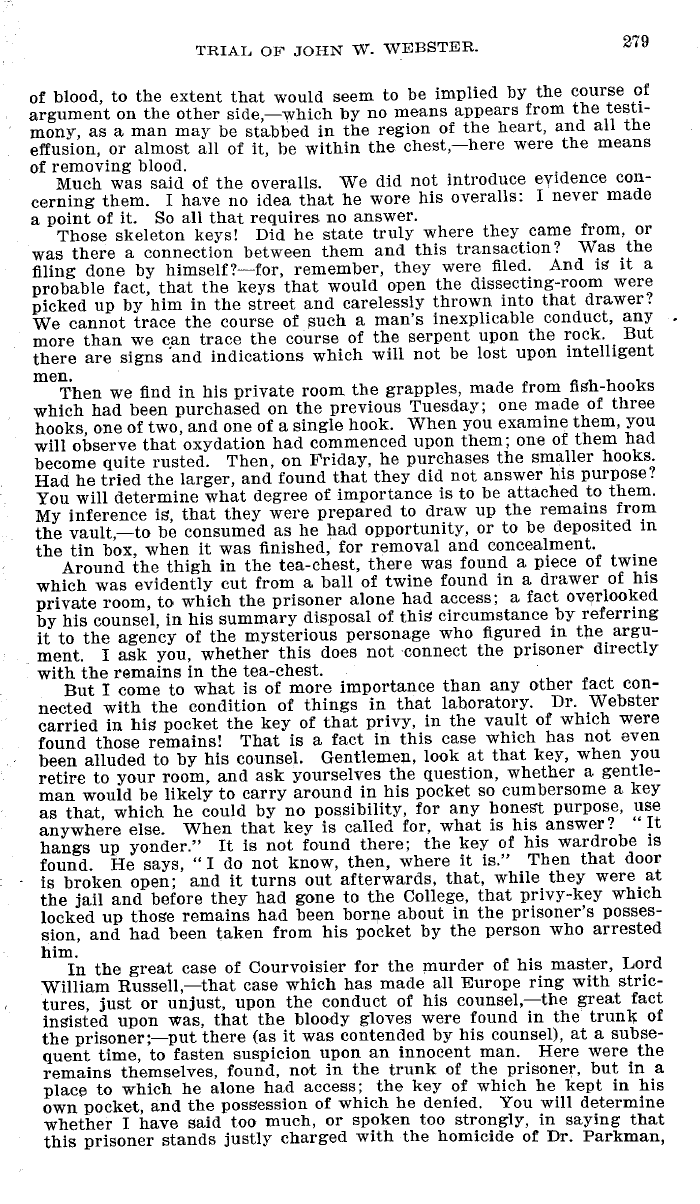|
TRIAL OF JOHN W. WEBSTER. 2'79
of blood, to the extent that would seem to be implied by the course of
argument on the other side,-which by no means appears from the testi-
mony, as a man may be stabbed in the region of the heart, and all the
effusion, or almost all of it, be within the chest,-here were the means
of removing blood.
Much was said of the overalls. We did not introduce evidence con-
cerning them. I have no idea that he wore his overalls: I never made
a point of it. So all that requires no answer.
Those skeleton keys! Did he state truly where they came from, or
was there a connection between them and this transaction? Was the
filing done by himself?-for, remember, they were filed. And is it a
probable fact, that the keys that would open the dissecting-room were
picked up by him in the street and carelessly thrown into that drawer?
We cannot trace the course of such a man's inexplicable conduct, any
more than we can trace the course of the serpent upon the rock. But
there are signs and indications which will not be lost upon intelligent
men.
Then we find in his private room the grapples, made from fish-hooks
which had been purchased on the previous Tuesday; one made of three
hooks, one of two, and one of a single hook. When you examine them, you
will observe that oxydation had commenced upon them; one of them had
become quite rusted. Then, on Friday, he purchases the smaller hooks.
Had he tried the larger, and found that they did not answer his purpose?
You will determine what degree of importance is to be attached to them.
My inference is, that they were prepared to draw up the remains from
the vault,-to be consumed as he had opportunity, or to be deposited in
the tin box, when it was finished, for removal and concealment.
Around the thigh in the tea-chest, there was found a piece of twine
which was evidently cut from a ball of twine found in a drawer of his
private room, to which the prisoner alone had access; a fact overlooked
by his counsel, in his summary disposal of this circumstance by referring
it to the agency of the mysterious personage who figured in the argu-
ment. I ask you, whether this does not connect the prisoner directly
with the remains in the tea-chest.
But I come to what is of more importance than any other fact con-
nected with the condition of things in that laboratory. Dr. Webster
carried in big pocket the key of that privy, in the vault of which were
found those remains! That is a fact in this case which has not even
been alluded to by his counsel. Gentlemen, look at that key, when you
retire to your room, and ask yourselves the question, whether a gentle-
man would be likely to carry around in his pocket so cumbersome a key
as that, which he could by no possibility, for any honest purpose, use
anywhere else. When that key is called for, what is his answer? " It
hangs up yonder." It is not found there; the key of his wardrobe is
found. He says, " I do not know, then, where it is." Then that door
is broken open; and it turns out afterwards, that, while they were at
the jail and before they had gone to the College, that privy-key which
locked up those remains had been borne about in the prisoner's posses-
sion, and had been taken from his pocket by the person who arrested
him.
In the great case of Courvoisier for the murder of his master, Lord
William Russell,-that case which has made all Europe ring with stric-
tures, just or unjust, upon the conduct of his counsel,-the great fact
ingisted upon was, that the bloody gloves were found in the trunk of
the prisoner; put there (as it was contended by his counsel), at a subse-
quent time, to fasten suspicion upon an innocent man. Here were the
remains themselves, found, not in the trunk of the prisoner, but in a
place to which he alone had access; the key of which he kept in his
own pocket, and the possession of which he denied. You will determine
whether I have said too much, or spoken too strongly, in saying that
this prisoner stands justly charged with the homicide of Dr. Parkman,
|

